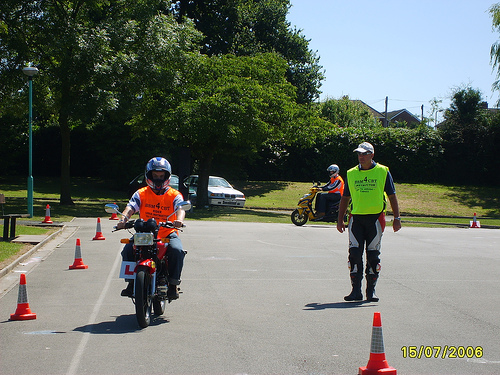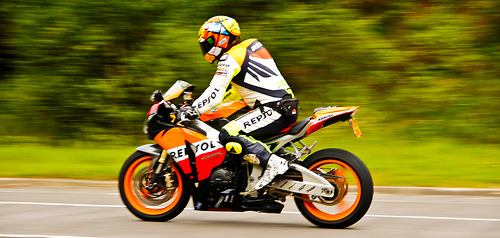|
Are you thinking of buying a motorbike? Before you can ride it on the road, you will need to follow the Highway Code by completing a Compulsory Basic Training course, also known as a CBT. Once you have passed the CBT you will be permitted to ride unaccompanied on the public road on a motorcycle up to 125 cc, with a power output not exceeding 11 kW. You must also ride with L-plates for up to two years. What does the CBT involve? The CBT course is designed to equip motorcyclists with the basic skills they need to ride safely on the road. Attendees are given a basic introduction to road safety and must carry out an eye test. They then have to do practical training, which teaches them how to control a bike, how to use gears, how to stop and start and how to carry out relevant safety checks. During the CBT course, motorcyclists have two hours accompanied on the road with a certified instructor. The instructor ensures that motorcyclists have the knowledge and skills to drive safely on the road and have a full understanding of the basics. If you successfully complete the CTB course, you will be given a DL196 certificate that permits you to ride a motorcycle solo up to 125cc, providing you are at least seventeen years old. You must display L-plates on the front and rear and must not carry passengers or ride on the motorway. Getting your full motorbike licence After passing your CBT, you will have two years to pass the theory and practical test to gain their full motorbike licence. If you do not pass within this time period, you will be required to retake your CBT. In order to gain your full motorbike licence you will need to first pass a theory test. This involves answering multiple-choice questions and completing a hazard perception test. Once you have passed your theory test, you will be able to take your practical motorcycle test. It is recommended that you read up on the Highway Code and have formal training beforehand. There are two types of full motorcycle licence. The first is a light motorcycle licence (A1) that restricts riders to any bike up to 125 cc and a power output of 11 kW. The standard motorcycle licence (A) restricts you to riding a bike up to 25 kW and a power / weight ratio not exceeding 0.16 kW / kg for the first two years. However after this period you can ride any size of bike. Highway Code rules for motorcyclists Section 83
All motorcyclists and pillion passengers must wear protective helmets. Helmets must comply with the regulations and should be fastened securely. This applies to riders of motorcycles, scooters, mopeds, tricycles and quad bikes. Section 84 Motorcyclists are advised to wear eye protectors that comply with the regulations. If they eye protectors are scratched or poorly fitted, it can limit their view and cause potential hazards. It is also recommended that you wear ear protection, as well as strong boots, gloves and suitable clothing that will help to protect you if you are involved in an accident. Section 85 Motorcyclists with a full bike licence are only permitted to carry one pillion passenger who will be required to sit astride the bike on a proper seat. They should sit forward, with both feet on the footrests. You should not carry a pillion passenger if your motorcycle is not designed to do so. Provisional licence holders are not permitted to carry a pillion passenger. Section 86 This section is all about making sure you are visible to other road users when riding in the daylight. Motorcyclists should wear a light or brightly coloured helmet, as well as florescent clothing or strips (often found on motorcycle jackets). Even with the right clothing, it is important to take extra care as other vehicle drivers may not see you or be able to judge your distance or speed correctly. Section 87 This section of the Highway Code explains what you should wear to make sure you are visible to other road users in the dark. It is recommended that you wear reflective clothing or strips to improve your visibility. These will reflect the light from the headlamps of other vehicles, helping them to spot you from a longer distance. Section 88 Section 88 of the Highway Code for CBT and motorbikes is all about manoeuvring. It is important that you are aware of what is behind and to the sides of you before manoeuvring. In traffic queues, you should always look for pedestrians crossing between vehicles, as well as vehicles changing lanes and emerging from junctions. Make sure you position your bike so that the drivers in front can see you in their mirrors. Always take great care and when filtering in slow-moving traffic, keep your speed low. We hope we have answered any questions you may have about the Highway Code for CBT and Highway Code for motorbikes in this article. If you would like any more information, feel free to get in touch. Image credits: One-Stop-Down and Natesh Ramasamy
23 Comments
stephen
12/5/2017 08:41:33
where to ride which side of the highway
Reply
Rachhpal Singh Atwal
9/8/2020 21:29:23
In the UK Drive on the Left side of the road.
Reply
Reece Tyler
30/12/2018 02:45:50
I found this article very helpful
Reply
Dawn Daffin
20/8/2019 11:47:52
Do you really think letting people out on whatever size bikes without knowledge of the roads. Signs. Etc is safe? Safe to the pedestrian or other road users including the bike owner?
Reply
Jamie
28/8/2019 14:36:25
They don’t let people out on whatever size bike they want, they have to take the CBT first and if an instructor doesn’t think you are ready they won’t let you on the road. Also during the CBT they will test your knowledge about the Highway Code to decide if it’s safe to let you ride. And during the road portion you are in constant communication with an instructor that is riding with you. Furthermore, even after gaining your CBT certification you are only allowed to ride a bike that is less the 125cc and you are also not allowed on motorways/highways or take passengers with you.
Reply
Rob
21/4/2022 00:58:46
Shows what you know, motorways aren't highways son. A new rider on cbt can use highways and dual carriageways. Don't try and mug people off when you're clueless yourself.
Claudia
22/9/2019 09:29:13
Dawn I know what you mean. I booked myself for the CBT and now I feel less confident about riding on the road, but at least I have an understanding of what's required in terms of bike and road knowledge. And I personally know that it is up to me to put in the extra effort before I join the common traffic flow.
Reply
24/2/2020 10:11:08
This article is so informative and helpful. I gather some important tips and informations to read this article.
Reply
TONY
14/7/2020 21:18:41
How Much of the HIghway Code do you need to learn for Basic CBT?
Reply
Vince Clark
28/4/2021 10:25:32
Try to read as much of the Highway Code as you can, its a bit boring I know but it will give you a lot of information about all road users, not just bike riders and as a result it could give you an idea of what other road users will do in any particular incident. Keep safe at all times.
Reply
Tim
7/6/2021 21:08:54
If you wish to live, I'd suggest all of it.
Reply
Mihai Serbanescu
19/12/2020 02:59:20
I'd like to travel the country, can I ride a 125cc bike with just the CBT on A and B roads? From London to Scotland on A and B roads on a 125cc bike, that would be nice.
Reply
Joseph
15/3/2021 18:28:32
When driving a moped scooter, up to a bollard dead end.
Reply
Tim
7/6/2021 21:04:21
It is illegal to drive/ride 'on the pavement'. You will neither be riding or driving in your scenario.
Reply
logan
10/5/2021 13:01:18
if you dont have any gear will they provide any?
Reply
Skye
15/6/2021 12:54:14
Is it legal for a person to ride a 125CC on a motorway? Given that the top speed is 60MPH?
Reply
Matthew
22/6/2021 14:02:44
Can you ride on the A21 with a CBT?
Reply
8/12/2021 23:09:13
But, there is an exception to Highway Code rule 83. It does not apply to followers of the Sikh religion if they wear a turban on a motorcycle.
Reply
28/12/2021 20:23:02
Try a random selection of questions for your motorbike licence theory test which covers all the Highway Code sections. All practise questions are multiple choice and will challenge your knowledge of the road rules.
Reply
Robin
15/6/2022 13:34:49
Question: Can I ride my 125cc scooter standing up... legally? I can see that 100 years ago early scooters were designed without seats to be ridden my men or women wearing their Sunday best. I have tried to read as many of the laws/rules as I can and some support being more visible, having better awareness etc, but I have not found anything specific about standing. Obviously being in control and maybe riding as the vehicle was intended might mean my scooter would need to be modified (the seat removed and floorboard extended). But, given the attention I am likely to attract, and curious policemen wanting to know... I need anything I can to make my case. Would using a historic vehicle help?
Reply
Your comment will be posted after it is approved.
Leave a Reply. |
Subscribe
|


